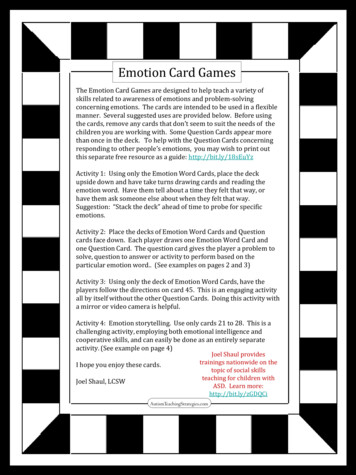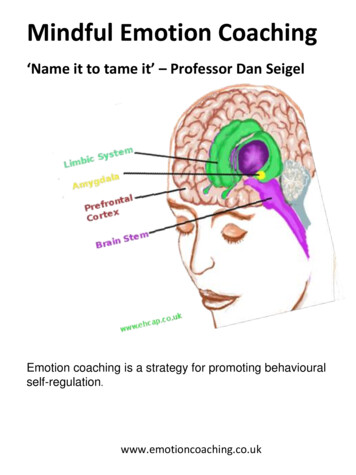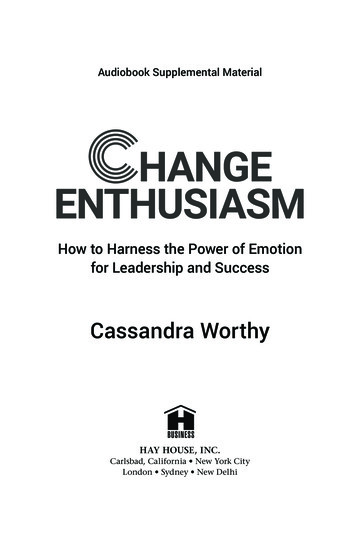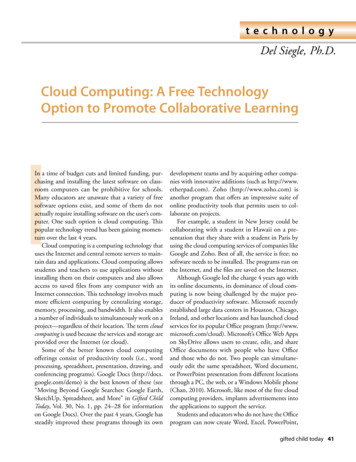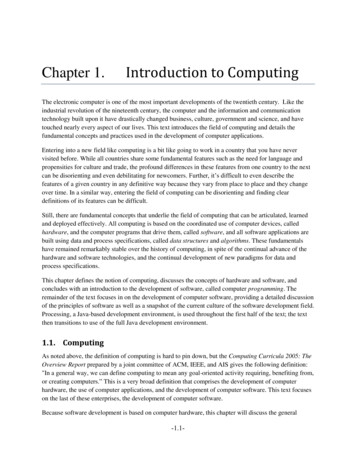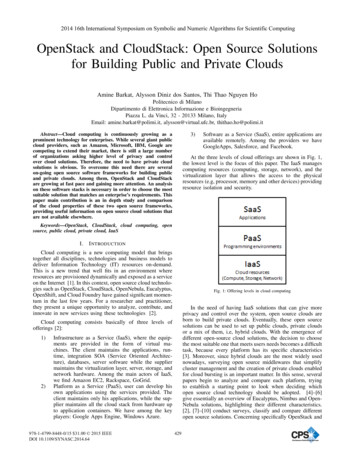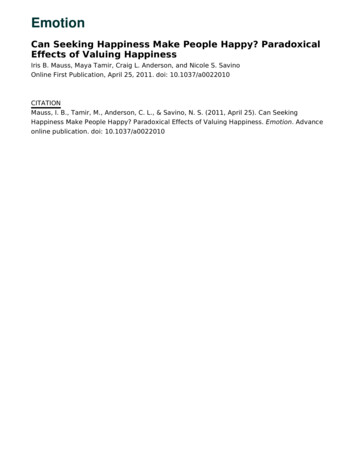
Transcription
EmotionCan Seeking Happiness Make People Happy? ParadoxicalEffects of Valuing HappinessIris B. Mauss, Maya Tamir, Craig L. Anderson, and Nicole S. SavinoOnline First Publication, April 25, 2011. doi: 10.1037/a0022010CITATIONMauss, I. B., Tamir, M., Anderson, C. L., & Savino, N. S. (2011, April 25). Can SeekingHappiness Make People Happy? Paradoxical Effects of Valuing Happiness. Emotion. Advanceonline publication. doi: 10.1037/a0022010
Emotion2011, Vol. , No. , 000 – 000 2011 American Psychological Association1528-3542/11/ 12.00 DOI: 10.1037/a0022010Can Seeking Happiness Make People Happy? Paradoxical Effects ofValuing HappinessIris B. MaussMaya TamirUniversity of DenverBoston College and Hebrew UniversityCraig L. AndersonNicole S. SavinoUniversity of California, BerkeleyUniversity of DenverHappiness is a key ingredient of well-being. It is thus reasonable to expect that valuing happiness willhave beneficial outcomes. We argue that this may not always be the case. Instead, valuing happinesscould be self-defeating, because the more people value happiness, the more likely they will feeldisappointed. This should apply particularly in positive situations, in which people have every reason tobe happy. Two studies support this hypothesis. In Study 1, female participants who valued happinessmore (vs. less) reported lower happiness when under conditions of low, but not high, life stress. In Study2, compared to a control group, female participants who were experimentally induced to value happinessreacted less positively to a happy, but not a sad, emotion induction. This effect was mediated byparticipants’ disappointment at their own feelings. Paradoxically, therefore, valuing happiness may leadpeople to be less happy just when happiness is within reach.Keywords: happiness, goal pursuit, emotion regulation, well-beingthe happier one will be. Models of goal pursuit (e.g., Mischel,Cantor, & Feldman, 1996) generally back up this intuition. According to such models, people’s values determine what they wantto achieve, which, in turn, will lead them to work toward that goal.This can be illustrated with an example from another domain: Aperson who highly values academic excellence will want toachieve high grades and, thus, study harder. All else being equal,valuing academic excellence will result in better grades. Applyingthis logic, valuing happiness should result in greater happiness.At a second glance, however, a particular feature of goal pursuitmay lead to possible negative outcomes of valuing happiness.People’s values determine not only what they want to achieve, butalso the standards against which they evaluate their achievements(Carver & Scheier, 1981). The person who highly values academicachievement and wants to achieve high grades is bound to bedisappointed at times when he falls short of his high standards. Inthe case of academic achievement, this may not matter for the goalat hand—someone can feel disappointed, but still achieve highgrades. However, in the case of happiness, this feature of goalpursuit may lead to paradoxical effects, because the outcome ofone’s evaluation (i.e., disappointment and discontent) is incompatible with one’s goal (i.e., happiness) (cf. Schooler, Ariely, &Loewenstein, 2003). This reasoning leads to a counterintuitivehypothesis: People who highly value happiness set happinessstandards that are difficult to obtain, leading them to feel disappointed about how they feel, paradoxically decreasing their happiness the more they want it.Disappointment at one’s achievements should be most likely insituations that seem conducive to high achievement. For instance,people who value academic achievement are more likely to feeldisappointed if they get a low grade at an easy class, compared toThose only are happy who have their minds fixed on some objectother than their own happiness. – Mill, 1873, p. 100Happiness is a crucial ingredient of human well-being andhealth (Duckworth, Steen, & Seligman, 2005; Fredrickson, 1998;Lyubomirsky, King, & Diener, 2005) and, therefore, people generally value happiness (Diener, 2000; Myers, 2000). Indeed, in anacknowledgment of its value, the pursuit of happiness was identified as an “inalienable right” in the United States Declaration ofIndependence. However, there is substantial variation in the extentto which people value happiness (Eid & Diener, 2001). Whereassome view it as a nice thing to have every now and then, others seeit as the sine qua non of their existence. The current investigationexamines how such differences in valuing happiness affect people’s actual happiness and well-being. We based our operationalization of happiness on a prominent definition in the presentcultural context, namely individuals’ emotional state (cf. Diener,2000; Kahneman, Diener, & Schwarz, 1999).At first glance, valuing happiness should lead to positive outcomes, because it is assumed that the more one values happiness,Iris B. Mauss and Nicole S. Savino, University of Denver; Maya Tamir,Boston College, and Hebrew University, Jerusalem, Israel; Craig L. Anderson, University of California, Berkeley.This study was supported by a grant from the National Institute onAging (1R21AG031967) awarded to Iris B. Mauss. The authors thankMatthew Boland, Leaf Van Boven, June Gruber, and Michelle N. Shiotafor their contributions to this research.Correspondence concerning this article should be addressed to IrisMauss, 2155 South Race Street, Department of Psychology, University ofDenver, Denver, CO 80208. E-mail: imauss@psy.du.edu1
2MAUSS, TAMIR, ANDERSON, AND SAVINOa hard one. Analogously, the paradoxical effect of valuing happiness should depend on the emotional context at hand. In relativelynegative situations, people can attribute their unhappiness to thecircumstances (cf. McFarland & Ross, 1982). For instance, peopleare unlikely to be disappointed if they fail to be happy after hearingthat a close friend had an accident. In contrast, in relativelypositive situations, people have every reason to feel happy and arelikely to feel disappointed when they do not. For instance, peoplewho value happiness may feel disappointed if they fail to feelhappy at their own birthday party. In summary, the more peoplevalue happiness, the less likely they may be to obtain it, especiallywhen happiness appears within reach.Little empirical research, to date, has directly tested these ideas.However, an experiment described in a chapter by Schooler andcolleagues (2003) provides data consistent with the notion that thepursuit of happiness may cause decreased happiness. This studyfound that participants who were told to “try to make yourself feelas happy as possible” while they listened to a piece of hedonicallyambiguous music reported feeling less positive mood, compared toa no-instruction control group. Although these findings offer relevant insight, they are difficult to fully judge because they arereported as part of a chapter. In addition, the study design calls forseveral extensions. First, the manipulation of happiness goals wasexplicit, raising questions about experimental demand. Second,mood was measured only explicitly and with self-reports, whichraises additional questions about experimental demand and validity of such measures as the sole index of emotional state (cf. Mauss& Robinson, 2009). Third, in this study, emotional context was notmanipulated. Because the model we described above leads one topredict paradoxical effects of valuing happiness in positive, but notnegative, emotional contexts, research is needed that examinesvaluing happiness in multiple emotional contexts.In sum, very little research has directly examined the idea thatvaluing happiness can negatively influence happiness. Therefore,the present research was aimed to examine this idea while addressing key limitations of existing research. Our approach was additionally guided by the wish to arrive at insights about longer termwell-being correlates as well as shorter term causal effects ofvaluing happiness. Therefore we obtained converging evidencefrom a correlational and an experimental study (cf. Cronbach,1957).In a first study, we examined whether individual differences invaluing happiness are related to happiness and well-being. Wehypothesized that the more people value happiness, the lower theirhappiness and well-being would be in relatively positive contexts(i.e., lower life stress), but not in relatively negative contexts (i.e.,higher life stress). In a second study, we examined the causaleffects of valuing happiness by experimentally manipulating it andmeasuring participants’ emotional reactions to either a positive ora negative emotion induction. Our experimental manipulation wastailored to be relatively implicit, to ascertain that values, ratherthan perceived experimental demand, were manipulated. We additionally reduced experimental demand by obtaining an implicit,as well as an explicit, measure of mood. We hypothesized thatmaking participants value happiness more would lead them to feelless happy in response to a relatively positive context (a happinessinduction), but not a relatively negative context (a sadness induction). We further expected this effect to be mediated by feelings ofdisappointment.Study 1Study 1 tested whether the degree to which individuals valuehappiness is associated with happiness and well-being. To do so,we recruited adult female participants from the community. Toassess a range of indices of happiness and well-being, we measured trait hedonic balance (i.e., ratio of positive to negativemood), subjective well-being, psychological well-being, and depression symptoms. To examine the moderating effect of context,we assessed levels of life stress that participants had experiencedin the past 18 months. We predicted that valuing happiness wouldbe associated with lower trait hedonic balance, subjective wellbeing, and psychological well-being, and greater depression symptoms under conditions of low, but not high, stress.MethodParticipants and procedure. Fifty-nine female participants(mean age 37.6 years, SD 12.3) were recruited from theDenver metro area through postings in online bulletins or in publicareas, such as laundromats and local hospitals. To ensure sufficientvariance in levels of stress, participants were recruited to haveexperienced a stressful life event (SLE) within 6 months prior tothe session. SLEs were defined to participants as events with adistinct onset (i.e., a relatively acute, instead of a chronic, stressor)that had a significant negative impact on their lives. Exampleswere provided to clarify what we meant (e.g., divorce, injury toself, injury or death of a close family member, sudden unemployment, and exposure to crime). In addition, all participants werescreened during an initial phone call to ensure that they metselection criteria. Because a pilot study showed no gender effectson happiness values (see below) and to minimize error variance inassociations between well-being and stress levels (and thus isolateeffects of happiness values), only women were recruited. Participants’ self-reported ethnic background was 81% European American, 4% Asian American, 4% Hispanic American, 6% AfricanAmerican, and 5% either mixed-race or other. Participants reported a range of family income levels (ranging from less than 10,000/year to more than 50,000/year) and educational backgrounds (ranging from partial completion of high school to graduate degree). Participants completed all surveys online at homeand received 15.Measures.Valuing happiness. Various measures exist that assess valuesand processes related to happiness, including values regardingspecific emotions in specific situations (Matsumoto, 1990; Timmers, Fischer, & Manstead, 2003) and ideal affective states (Tsai,Knutson, & Fung, 2006). However, none of these scales capturesthe construct we set out to examine: valuing happiness to apotentially extreme degree. We thus developed a measure thatwould capture such values. Because our scale needed to correspond to the present, western cultural context, we equated happiness to a prominent definition in this context: an individual’spositive hedonic state. We generated items by examining existingscales of emotion-related values (e.g., affect valuation, Tsai et al.,2006; emotion control values, Mauss, Butler, Roberts, & Chu,2010) and by asking members of our research teams to describetheir values regarding happiness. A process of validity and reliability checks yielded seven items, each rated on a 7-point Likert
PARADOXICAL EFFECTS OF VALUING HAPPINESSscale from 1 (strongly disagree) to 7 (strongly agree).1 A pilot test(N 292; 50% male; mean age 39.8 years, SD 11.8)indicated adequate internal consistency ( .76) and no genderdifferences, t(290) .77, p .38. An exploratory factor analysissupported that a one-factor solution was the most appropriate, witha first initial factor producing an Eigenvalue of 2.9 and explaining41% of the variance. All seven items loaded positively on thisfactor, with all coefficients above .54. This factor was followedby one factor with an Eigenvalue of 1.2 that explained anadditional 17% of the variance. Because the Eigenvalue of thisfactor was barely above 1 and because factor loadings on thisfactor were lower and did not yield a conceptually cohesivesecond factor, the one-factor solution was most appropriate.Life stress. Stress was measured using the Life ExperiencesSurvey (LES; Sarason, Johnson, & Siegel, 1978). The LES consists of 45 items assessing a range of potentially stressful events(e.g., death of a family member). Participants indicated for eachitem if a particular event had occurred in the past 18 months andthe impact of that event ( 3 extremely negative; 3 extremely positive). Like others (e.g., Herrington, Matheny, Curlette,McCarthy, & Penick, 2005), we only used the negative impact ofevents because positive events are less reliable predictors of wellbeing (e.g., Vinokur & Selzer, 1975). We summed impact ratingsacross all events to arrive at one cumulative stress score. Stressscores ranged from 0 to 39 (M 10.9, SD 9.5). To decrease theimpact of two outliers ( 2 SDs from the mean), we winsorizedthem to the 90th percentile (22.5). Stress was not related to age,ethnicity, family income, education, or valuing happiness ( ps .13).Happiness and well-being. Trait hedonic balance was assessed as the ratio of positive over negative affect from the two10-item subscales of the Positive and Negative Affect Schedule(Watson, Clark, & Tellegen, 1988). Subjective well-being wasmeasured with the 5-item Satisfaction with Life Scale (Diener,Emmons, Larsen, & Griffin, 1985). Psychological well-being wasassessed with the 18-item Scales for Psychological Well-Being(Ryff & Keyes, 1995). Depression symptoms were measured withthe 22-item Inventory to Diagnose Depression (Zimmerman &Coryell, 1986). One item concerning suicidality was omitted fromthis scale due to Institutional Review Board concerns. All fourmeasures were normally distributed according to tests of kurtosisand skewness. Scale descriptives and internal consistency coefficients are provided in rows 2 and 3 of Table 1.ResultsA multivariate analysis of variance (MANOVA) with hedonicbalance, psychological well-being, satisfaction with life, and depression symptoms as dependent variables and valuing happiness,stress level, and the valuing happiness by stress interaction asmean-centered, continuous predictor variables indicated significant effects of valuing happiness, F(4, 49) 4.9, p .01, 2p .29, stress level, F(4, 49) 3.7, p .01, 2p .23, and the valuinghappiness by stress interaction, F(4, 49) 2.6, p .05, 2p .17.Stress level was associated with lower hedonic balance, lowerpsychological well-being, less satisfaction with life, and higherlevels of depression symptoms2 (see Table 1, row 4). Valuinghappiness was associated with lower hedonic balance, lower psychological well-being, less satisfaction with life, and higher levels3of depression symptoms (see Table 1, row 5). As expected, each ofthese main effects of valuing happiness was qualified by stresslevel, as indicated by significant interactions between valuinghappiness and stress level (see Table 1, row 6). As illustrated inFigure 1 and summarized in Table 1, rows 7 and 8, simple slopesanalyses (Aiken & West, 1991) indicated that at lower, but nothigher, life stress, the more participants valued happiness, thelower their hedonic balance, psychological well-being, and satisfaction with life, and the higher their depression symptoms.3DiscussionResults of Study 1 suggest that valuing happiness is not necessarily linked to greater happiness. In fact, under certain conditions,the opposite is true. Under conditions of low (but not high) lifestress, the more people valued happiness, the lower were theirhedonic balance, psychological well-being, and life satisfaction,and the higher their depression symptoms.This pattern of associations was found across four distinctdomains, including hedonic balance, subjective well-being, psychological well-being, and depression symptoms. Although thesedomains covary (absolute intercorrelations ranged from .67 to .82in the present study), they are conceptually distinct (e.g., Ryff &Keyes, 1995; Ryff et al., 2006). Thus, the paradoxical effects ofvaluing happiness may not be constrained to hedonic well-beingand are relatively reliable.Although these findings are consistent with the hypothesis thatvaluing happiness can lead to less happiness, Study 1 is correlational and thus open to alternative interpretations. Most notably,associations between valuing happiness and well-being might bedue to third variables or effects of well-being. For instance, beingunhappy may lead people to value happiness to a greater extent.The fact that we found relationships between valuing happinessand outcomes only under conditions of low stress makes thisinterpretation less plausible, because it is difficult to explain whyfeeling unhappy would lead people to value happiness only whenthey experience low levels of life stress. Nonetheless, to bolstercausal interpretations, an experimental manipulation of happinessvalues was necessary. Study 2 was designed to provide such amanipulation.1The seven items were as follows. 1. How happy I am at any givenmoment says a lot about how worthwhile my life is. 2. If I don’t feel happy,maybe there is something wrong with me. 3. I value things in life only tothe extent that they influence my personal happiness. 4. I would like to behappier than I generally am. 5. Feeling happy is extremely important to me.6. I am concerned about my happiness even when I feel happy. 7. To havea meaningful life, I need to feel happy most of the time.2Because variance of depression symptoms was greater in the higherthan the lower stress group (at 1 SD of stress), we log-transformeddepression symptoms, which yielded equal variances. All results wereequivalent with log-transformed and nontransformed data. Therefore, figures and means present nontransformed scores.3Lack of effects in the group of highly stressed women were likely notdue to floor effects, as Levene tests confirmed that there were equalvariances across lower and higher stress groups.
MAUSS, TAMIR, ANDERSON, AND SAVINO4Table 1Study 1 ResultsMeans (SDs) Standardized s of main effects of stressStandardized s of main effects of valuing happinessStandardized s of interactions between valuing happiness and stressSimple slopes analyses: Standardized s of effects of valuing happiness at each level of stressLow stressHigh calwell-beingDepressionsymptoms1.88 (.94).92 .60ⴱⴱⴱ .39ⴱⴱ.45ⴱⴱ3.92 (1.57).90 .55ⴱⴱⴱ .33ⴱⴱ.32ⴱ4.53 (.80).87 .57ⴱⴱⴱ .43ⴱⴱⴱ.38ⴱⴱ17.0 (10.9).85 .75ⴱⴱⴱ.05 .60ⴱⴱ .03 .76ⴱⴱⴱ .09.59ⴱⴱ .13.30ⴱ .41ⴱⴱNote. Rows 2 and 3: Descriptives and s of Trait Hedonic Balance, Subjective Well-being, Psychological Well-being, and Depression Symptoms; Row4: Main Effects of Stress Level on Trait Hedonic Balance, Subjective Well-being, Psychological Well-being, and Depression Symptoms; Row 5: MainEffects of Valuing Happiness; Row 6: Interaction Between Valuing Happiness and Stress Level. Rows 7 and 8: Summary of Simple Slopes AnalysesDecomposing the Interactions. N 59.ⴱp .05. ⴱⴱ p .01. ⴱⴱⴱ p .001.Study 2In Study 2, we examined the causal effects of happiness values.To do so, we experimentally manipulated the extent to whichpeople valued happiness and assessed emotional reactions to arelatively positive and a relatively negative laboratory context.Compared to a control group, we expected participants who wereled to value happiness to feel less happy in the positive, but not thenegative, context. We further predicted that the effect of theexperimental manipulation would be mediated by participants’disappointment at their emotional reactions. To lead participants tovalue happiness while minimizing experimental demand, we useda fake newspaper article extolling the importance of happiness (cf.Hong, Chiu, Dweck, Lin, & Wan, 1999). This manipulation wasgeared to closely match the values we measured in Study 1. Tomanipulate emotional context in a standardized fashion (an important feature to rule out potential confounds such as positive emotional reactivity or the generation of particular emotional contextsby particular individuals), we used film clips pretested to inducehappiness or sadness. Crossing these two factors (valuing happiness vs. experimental control and happy vs. sad context) resultedin four experimental groups: valuing happiness/happy emotioninduction, valuing happiness/sad emotion induction, experimentalcontrol/happy emotion induction, and experimental control/sademotion induction. Finally, to further minimize concerns aboutexperimental demand, we used an implicit, as well as an explicit,measure of emotional experiences.MethodParticipants. Seventy women (mean age 21.1 years, SD 2.2) participated in exchange for course credit or 20. Participants’self-reported ethnic background was 57.7% European American,7.0% Asian American, 11.3% Hispanic American, 8.5% AfricanAmerican, 1.4% Pacific-Islander, 1.4% mixed, and 12.7% other orrefused to report.During the funneled debriefing (cf. Bargh & Chartrand, 2000),one participant (from the valuing happiness/sad film-clip group)expressed strong suspicion about the nature of the faux newspaperarticle manipulation and was excluded from analyses, leaving 69participants.Procedure. To minimize experimental demand, participantswere told they were in a study about “TV programming.” Then, toneutralize and equate emotional states across participants, theywatched a 2-min affectively neutral film clip. Participants werethen randomly assigned to either a “valuing happiness” or a controlmanipulation. Participants in the “valuing happiness” conditionwere told the following:“People who report higher than normal levels of happinessexperience benefits in their social relationships, professional success, and overall health and well-being. That is, happiness not onlyfeels good, it also carries important benefits: the happier peoplecan make themselves feel from moment to moment, the morelikely they are to be successful, healthy, and popular. (. . .). In fact,recent research shows that people who are able to achieve thegreatest amount of happiness (. . .) can experience long-term beneficial outcomes. (. . .).”Participants in the control condition read the same paragraph,except that all references to happiness were replaced by “makingaccurate judgments.”4After participants underwent the valuing happiness manipulation, they were randomly assigned to watch either a happy or a sad2-min film clip, pretested to primarily evoke the target emotion.The happy film clip showed a popular female figure skater win4To ensure that the experimental manipulation was effective, we ran apilot study in which 40 participants were randomly assigned to either theexperimental or the control manipulation and then completed the happinessvalues scale used in Study 1. Supporting the effectiveness of our manipulation, an ANOVA revealed that participants in the experimental conditionvalued happiness more than those in the control condition (Ms [SDs] 4.6[0.85] and 4.0 [0.75], respectively), F(1, 38) 5.27, p .03, 2p .12.To ensure that the experimental manipulation itself did not lead todifferences in mood, we ran another pilot study in which 37 participantswere randomly assigned to either the experimental or the control manipulation and then watched a 2-min emotionally neutral film clip. They thenrated their mood, using the same measure used in Study 2. Supporting thatthe manipulation paragraphs per se did not lead to differences in mood, anANOVA revealed that participants in the two conditions did not differ fromone another in terms of hedonic balance (Ms [SDs] 3.3 [1.83] and 3.5[2.29], respectively), F(1, 35) .04, p .84, 2p .001. The randomization check from Study 2 confirmed these results.
PARADOXICAL EFFECTS OF VALUING HAPPINESS5polygons ( .67), provided in one random order. Positivefeelings tend to be associated with more positive judgments (e.g.,Mayer & Hanson, 1995), and thus greater liking of the polygonsindicates more positive mood.To explicitly measure emotional state, participants then rated ona 1 (none) to 9 (extremely) scale the maximal extent to which,during the film clip, they had experienced two positive emotions(joy and happiness; .96) and seven negative emotions (anxiety, sadness, shame, worry, nervousness, frustration, and tension; .90). As in Study 1, we formed an index of hedonic balanceby taking the ratio of positive to negative emotion. The correlationbetween the implicit and the explicit measures was positive butmodest (r .29, p .01), indicating that the two measures werenot redundant with one another.To ascertain the effectiveness of the happiness values manipulation, participants then rated to what extent they had “tried to feelmore positive during the previous film clip” on a 1 (none) to 9(extremely) Likert scale. To assess a key mediator, participantsrated to what extent they had “felt disappointed during the previous film clip” and “should have enjoyed the film clip more” on a1 (none) to 9 (extremely) Likert scale ( .68). All measures werenormally distributed according to tests of kurtosis and skewness.ResultsFigure 1. Study 1: Mean trait hedonic balance (positive/negative mood;panel A), subjective well-being (B), psychological well-being (C), anddepression symptoms (D) as a function of participants’ levels of valuinghappiness (low vs. high) and emotional context (low vs. high stress).Values depict estimates at 1 SD for values and levels of life stress. Errorbars are standard error of the mean (SEM).ning a gold medal, the audience’s enthusiastic reaction, and hercelebrating with her coach. The sad film clip showed a happycouple in love spending a night out dancing, the wife’s suddendeath, and ends with the husband arriving to an empty home (cf.Rottenberg, Ray, & Gross, 2007). After watching the film clip,participants completed an implicit measure of their emotionalstate, in which they rated how much they liked each of two abstractRandomization check. After watching the neutral film clipand before the experimental manipulation, the four experimentalgroups did not differ from one another in terms of hedonic balance,implicit mood, attempts to feel more positively, and disappointment, as indicated by four ANOVAs with values condition andfilm-clip valence as independent variables, Fs(1, 65) .79, ps .40.Manipulation check: Emotional film clips. The film clipsinduced the intended emotions, as indicated by hedonic balance inthe control group, which was greater for the happy than for the sadfilm clip, groupwise t(33) 8.96, p .001, greater for the happythan for the neutral film clip, pairwise t(16) 2.24, p .04, andlower for the sad than for the neutral film clip, pairwise t(17) 5.97, p .001 (Means [SDs] happy film clip: 5.8 [2.3]; sad filmclip: 0.9 [0.6]; neutral film clip: 4.4 [2.1]).Manipulation check: Effectiveness of the valuing happinessmanipulation.An ANOVA with values condition and filmvalence condition as independent variables indicated that the values manipulation worked as intended. Participants in the valuinghappiness condition indicated that they tried harder than those inthe control condition to feel positively, F(1, 65) 16.79, p .001, 2p .21 (Means [SDs] valuing happiness group: 4.7 [1.9], controlgroup: 2.6 [2.3]). There were no effects involving film-clip valenceon participants’ attempts to feel more positively, Fs(1,65) 1.26,ps .27.Effects of valuing happiness on explicitly measured emotion.We predicted that leading participants to value happiness (compared to the control group) would lead them to experience morenegative hedonic balance in a happy, but not a sad, emotionalcontext. Consistent with this hypothesis, an ANOVA with happiness values condition and film valence condition as independentvariables and explicitly measured emotion as a dependent variableindicated a significant Happiness Values Film Valence interac-
6MAUSS, TAMIR, ANDERSON, AND SAVINOtion, F(1, 65) 5.65, p .02, 2p .08 (see Figure 2).5 Follow-upt tests indicated that participants who were led to value happinessexhibited more negative hedonic balance than participants in thecontrol condition during the happy film clip, t(33) 2.46, p .02, 2p .15, but not the sad film clip, t(32) .83, p .41.6Effects of valuing happiness on implicitly measured emotion. We ran a similar analysis to the one used for explicitlymeasured emotion, using implicitly measured emotion as the dependent variable. As predicted, we found a significant HappinessValues Film Valence interaction, F(1, 65) 5.47, p .02, 2p .08 (see Figure 3). Fo
positive situations, people have every reason to feel happy and are likely to feel disappointed when they do not. For instance, people who value happiness may feel disappointed if they fail to feel happy at their own birthday party. In summary, the more people value happin
